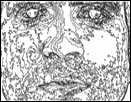
Examples of previous work:
Moving image poem mixes text into image-phrases pushing the boundaries of perception and the conscious fixation on identity.
From primordial soup, a cell forms. Over time, many cells group together, forming larger and more complex entities. Each person, now a great ball of cells. What will be the next step in evolution as each one of us becomes a cell in the new body?
This work enables the viewer to watch their mind at work. Words form into images, activate meaning, label and influence visual perceptions. While this happens, the viewer is able to disassociate from the workings of the mind, watching it as an operating mechanism, and through this separation, a watcher/entity is revealed.
Film version (2005)
Simulacra is a short film created with a technique known as Machinima. This technique uses videogame engines in order to make it possible to shoot a film from within virtual-reality environments. These environments can be hacked or customized, or as with the case of the Simulacra movie, created entirely from scratch by the artist.
Shot from within a gaming environment, Simulacra takes a hard critical look at games that we are continuously engaged in. Just as virtual-reality is a consensual hallucination, structures such as money, power, borders, ownership, and tele-presence are also consensual dreams. These thought infrastructures are so deeply embedded within our psyche that they become manifest in physical reality and affect popular views of power, luxury, war, and oppression. Simulacra comments on our own created ‘virtual’ reality. The representations within this work are of nothing real, only a mirroring of the representations that we already live in.
Simulacra moves through a series of ten imaginary environments, each a metaphor for narratives that are performed in meat-space reality. The videogame camera controlled in real-time, keeps the story in first person and places a continuous awareness on the position of the spectator. The viewer, playing a critical role in terms of analytical perspective, is never released into the role of impartial observer. As many familiar sounds are packed closely together in a dense audio montage, surreal images (rendered by the game engine with photographic precision) are juxtaposed together in a continuously surprising and frenetic pace. Drawing parallels to Lewis Carroll’s mirror, reality is distorted but still maintains an inherent internal logic.
Similar to how dreams are re-symbolized replays of the day’s events, the constructed spaces of Simulacra re-contextualize familiar sounds and image elements into a new vision. In this way, the usual narratives are de-familiarized, creating a new opportunity for examination.
Self Interview is a video and live-performance hybrid in which a life-size prerecorded projection of myself interviews me in front of a live audience. The timing of the questions that the video projection asks is controlled by a DVD remote control that I hold in my hand. By this method, I am able to answer questions spontaneously, similar to a ‘real’ interview.
In Self-Interview, the interviewer (my projected self) asks pointed questions concerning the nature of art; what it is that artists actually do; what it means to work with an artist’s own image; the consequences of being observed; scripted conversations; and the relationship between the self and the projected-self. In this way, the piece becomes entirely self-reflexive both in form and in content. The reality of how having sets-of-expectations can influence or even dictate conversations and thought is explored during this interview process. The concept of one projecting ones own perspectives on the communication of others gets played out and literalized in this drama. Finally, it is decided that there is no difference between the self and the self that is projected upon others (like a set of clothing or a costume for interpretation) and so differences between people gets negated. For each one of us, the entire population of the world appears like a single repeating entity; everyone is the same. Human action, interaction, and free-agency take on a layer of inevitability. The motivation for every person’s action gets processed through the filter of self-projection.
By this interpretation, there is only one person that acts; furthermore, this one person’s actions are scripted and predetermined by the narrative of cultural expectations.
Ultimately, Self Interview turns the mirror towards the audience, casting everyone as a projection.